高级微观经济学博弈论讲义复旦大学CCESYongqinWang1
- 格式:ppt
- 大小:4.06 MB
- 文档页数:255
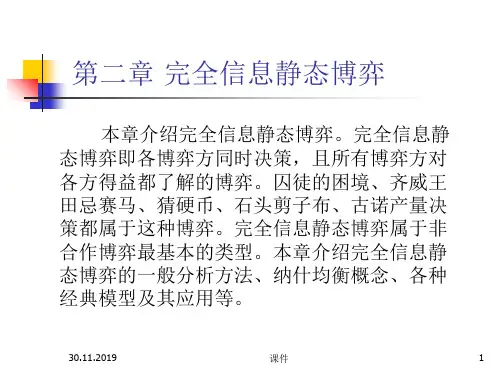
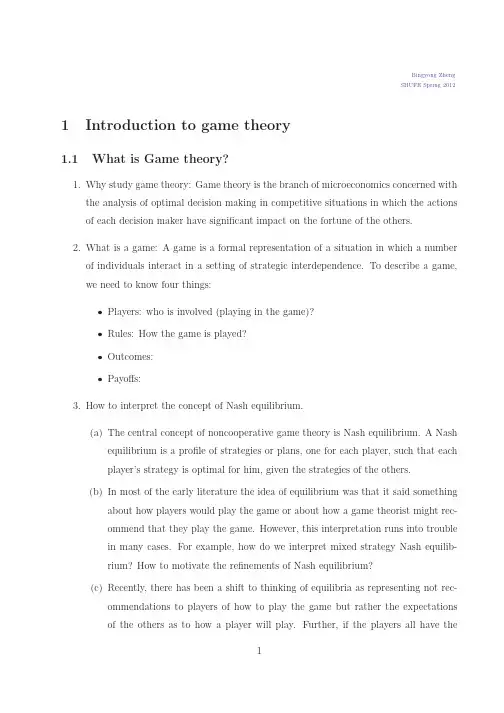
Bingyong ZhengSHUFE Spring2012 1Introduction to game theory1.1What is Game theory?1.Why study game theory:Game theory is the branch of microeconomics concerned withthe analysis of optimal decision making in competitive situations in which the actions of each decision maker have significant impact on the fortune of the others.2.What is a game:A game is a formal representation of a situation in which a numberof individuals interact in a setting of strategic interdependence.To describe a game, we need to know four things:•Players:who is involved(playing in the game)?•Rules:How the game is played?•Outcomes:•Payoffs:3.How to interpret the concept of Nash equilibrium.(a)The central concept of noncooperative game theory is Nash equilibrium.A Nashequilibrium is a profile of strategies or plans,one for each player,such that eachplayer’s strategy is optimal for him,given the strategies of the others.(b)In most of the early literature the idea of equilibrium was that it said somethingabout how players would play the game or about how a game theorist might rec-ommend that they play the game.However,this interpretation runs into troublein many cases.For example,how do we interpret mixed strategy Nash equilib-rium?How to motivate the refinements of Nash equilibrium?(c)Recently,there has been a shift to thinking of equilibria as representing not rec-ommendations to players of how to play the game but rather the expectationsof the others as to how a player will play.Further,if the players all have thesame expectations about the play of the other players we could as well think ofan outside observer having the same information about the players as they haveabout each other.1.2Rationality and common knowledege1.Rationality Assumption:mon knowledge:A standard assumption is that the game(players,strategies,andpayofffunctions)is common knowledge among mon knowledge is an important concept in game theory.A fact is common knowledge among players if each player knows the fact,and each player knows everyone else knows,and each knows everyone else knows everyone else knows,and so on.For example,a handshake is common knowledge between the two persons involved.When I shake hand with you,I know you know I know you know,.....,that we shake hand.Neither person can convince the other that she does not know that they shake hand.So,perhaps it is not entirely random that we sometimes use a handshake to signal an agreement or a deal.3.What if we don’t have common knowledge?Example1:Muddy children puzzlen children playing together.Each child wants to keep clean,but each would love to see the others get dirty.Now it happens during their play that some of the children, say k(k>1)of them,get mud on their foreheads.Each can see the mud on others but no on his own forehead.No one says a thing.Along comes the father,who says,“At least one of you has mud on your forehead.”The father then asks the following question,over and over:“Does any of you know whether you have mud on your own forehead?”Assuming that all the children are perceptive,intelligent,truthful,and that they answer simultaneously,what will happen?Example2:The general’s problemTwo divisions of an army,each commanded by a general,camped on two hilltops overlooking a valley the enemy stays.If both divisions attack the enemy simultaneously they will win the battle,while if only one division attacks it will be defeated.Neithergeneral will attack unless he is absolutely sure that the other will attack with him:a general will not attack if he receives no messages.The general of thefirst divisionwishes to coordinate a simultaneously attack(at some time the next day).They can communicate only by means of messengers.Normally,it takes a messenger one hour to get from on encampment to the other and on this particular night,everything goes smoothly.How long will it takes them to coordinate an attack?2Strategic form game2.1An subjective expected-utility maximization approach1.Definition:A strategic form game is a tuple G=(S i,u i)n i=1,where for all i,S i is theset of strategies available to player i,and u i:×n j=1S j→R is i’s payoffas a function of strategies chosen by all players.2.An subjective expected-utility approach interpretation(a)Each player has a subjective probability distribution over all states of the world–more precisely,the probabilities that her opponents playing s−i for all s−i∈×j=i S j.(b)Each player acts as an expected utility maximizer,choosing a strategy that max-imizes her expected payoffin the game given the probability distribution over thestrategies of her opponents.This is common knowledge.(c)The concept of Nash equilibrium imposes a further restriction,player’s belief isconsistent with the actual play of her opponents.3.The above interpretation of subjective expected utility-maximization provides a deci-sion theoretical foundation to the traditional definition of Nash equilibrium that each player plays optimally given the other players’equilibrium strategies.4.An important feature of the subjective expected utility approach is that it does notrequire randomization on the part of the players.Recall that the traditional interpre-tation of mixed strategies that assumes players explicitly randomize.The probabilisticnature of strategies now reflects the uncertainty of other players about a player’s choice.Thinking about the traditional Chinese“Scissor-rock-cloth”game.2.2Prisoner’s dilemma gameThe capacity expansion game between Honda and ToyotaToyotaBuild Do not buildHonda Build16,1620,15Do not build15,2018,181.Players:Toyota,Honda.2.Rules:Twofirms simultaneously choose to expand or not.Strategies for eachfirm:Build,Do not build.3.4outcomes:(Build,Build),(Build,Do not build),(Do not build,Build),(Do notbuild,Do not build).4.Payoffs:5.Nash equilibrium of this game:(Build,Build).2.3Strategies1.Definition:A strategy s i specifies the actions that a player will take under any con-ceivable circumstances that the player might face.2.A strategy is a complete contingency plan that says what a player will do at each ofher information sets if she is called on to play there3.A player’s strategy may include plans for actions that her own strategy makes irrele-vant.4.One interpretation for the specification of choices at information sets that won’t bereached given his strategy is that they are beliefs of his opponents about what he would do in case he does not follow his strategy,i.e.,the informations were reached.The belief of his opponents is important as their choices at those information sets are based on this belief.Furthermore,what the player’s opponents would do at those information sets rationalize his choice at at an upstream information set.Hence,this definition of strategy is not so odd when you interpret it as the way a player determines his strategy.5.Pure strategy and mixed strategyA mixed strategyσi∈∆(S i)specifies probabilities to two or more pure strategies.For example,the traditional Chinese game,rock,scissor and cloth.player2scissor rock clothPlayer1scissor0,0-1,11,-1rock1,-10,0-1,1cloth-1,11,-10,0Example2.A game of“match the coin”:Both players,Tom and Jack,choose whether to place the coin Head up or Tail up.Jack wins if two“Head”or two“Tail”appear, and loses otherwise.JackHead TailTom Head-1,11,-1Tail1,-1-1,12.3.1Dominant strategy1.Dominant strategy:A strategy s i is dominant for player i if for all s−i∈S−i ands′i∈S i/s iu i(s i,s−i)>u i(s′i,s−i).A strategy is a dominant strategy for a player if it is better than other strategies,nomatter what the others will choose.In any Nash equilibrium,players who have a dominant strategy play the dominant strategy.Thus,it is easy tofind the Nash equilibrium of games in which some of the players have a dominant strategy.2.“Confess”is a dominant strategy for prisoner1and prisoner2.Prisoner1Confess Not confessPrisoner2Confess-5,-50,-10Not confess-10,0-1,-13.Dominant strategies are rarity rather than norm.There is no dominant strategies inmost interesting games.2.3.2Dominated strategy1.A pure strategy s i∈S i is weakly dominated if there is another strategy s′i∈S i suchthat for all s−i∈S−i,u i(s′i,s−i)≥u i(s i,s−i),with strict inequality for some s−i.A strategy s i is strictly dominated for player i if there is another strategy s′i∈S i suchthat for all s−i∈S−iu i(s′i,s−i)>u i(s i,s−i).A strategy is strictly dominated when the player has another strategy that gives hera higher payoffno matter what the other player plays.2.Allowing mixed strategy:•A strategyσi is strictly dominated for player i if there is another strategyσ′i∈∆(S i)/σi such that for allσ−i∈∆(S−i)u i(σi,σ−i)<u i(σ′i,σ−i).•A pure strategy s i is strictly dominated for player i if and only if there existsσi∈∆(S i)such thatu i(s i,s−i)<u i(σi,s−i)for all s−i.3.A mixed strategy that assigns positive probability to a pure strategy that is strictlydominated is also strictly dominated.4.Modifies capacity expansion game between Toyota and HondaToyotalarge small not buildHonda large0,012,818,9small8,1216,1620,15not build9,1815,2018,18“large”is a dominated strategy for bothfirm as it can do better by choosing “small”,regardless of what the otherfirm is going to do.5.A player will not play a dominated strategy in Nash equilibrium.2.4Nash equilibrium2.4.1Definition and interpretation1.Definition:A strategy profile s∗=(s∗1,...,s∗n)is a Nash Equilibrium(NE)if for alli∈N and for all s′i∈S iU i s∗i,s∗−i ≥U i s′i,s∗−i .2.The central concept of noncooperative game theory is Nash equilibrium.A Nashequilibrium is a profile of strategies such that for each player in the game,given the strategy chosen by the other players,the strategy is a best response for the player, that is,the strategy gives the player the highest payoff.3.In early literature,the idea of equilibrium was that it said something about how playerswould play the game,or how game theorists would recommend them to play the game.More recently,game theorists look to an alternative interpretation.According to this interpretation,an equilibrium is taken as every player making optimal choice given the belief about how opponents would play the game given their respective beliefs.4.While thefirst interpretation of the equilibrium can be problematic in case of mixedstrategy equilibrium,the second interpretation can accommodate mixed strategies without any trouble.In this scenario,the mixed strategy of a player does not rep-resent a conscious randomization on the part of that player,but rather the uncertainty in the minds of the others as to how that player will act.Hence,the second inter-pretation of Nash equilibrium has become the preferred interpretation among game theorists.Thus the focus of the equilibrium analysis becomes,not the choices of the players, but the assessments of the players about the choices of the others.The basic consis-tency condition that we impose on the players’assessments is this:A player reasoning through the conclusions that others would draw from their assessments should not be led to revise his own assessment.2.4.2Find NE in two-player gamesIn games with dominant and dominated strategies1.Most games havefinite and ODD number of NE.Example:L M RT3,30,23,0B0,03,20,32.If both players have a dominant strategy,then playing dominant strategies is the uniqueNash equilibrium in the game.3.If one player has a dominant strategy,this strategy will be this player’s NE strat-egy.The other player’s NE strategy is the best response to her opponent’s dominant strategy.4.If players have dominated strategies,delete the dominated strategies from the gameand work with a smaller game.ExamplePlayer2A B CPlayer1A5,815,1010,5B10,1520,915,0C20,2010,1010,85.NE must be a mutual best-response,that,given player1plays NE strategy,player2can not do better by playing some other strategies,similarly,given player2plays this strategy,player1can not do better by changing strategies.A NE is a strategy profile in which both players are playing the best-response given the other player’s strategy.2.4.3Three player game1.A simple examplePlayer2U D Player1A(1,1,0)(2,-2,5)B(1,-2,-1)(0,3,1)Player2U D Player1A(1,1,-2)(2,-2,5)B(2,2,-1)(2,3,7)Player3plays L Player3plays R Pure strategy NE in this game:(A,U,L),(B,D,R).2.Another examplePlayer2U V WL3,0,22,-1,01,-2,0 Player1M3,2,11,4,-10,0,-2R1,1,100,2,1-2,0,3Player2U V WL2,1,13,0,02,-2,-1 M5,4,21,3,43,0,-2 R1,1,10,2,0-2,0,2Player3plays A Player3plays BPlayer2U V WL2,1,-13,0,-12,-2,-3Player1M5,4,-11,3,-23,0,-4R1,1,-100,2,-1-2,0,-2Player3plays CPlayer1’s dominated strategy R,player2’s dominated strategy W.Player3’s domi-nated strategy C.The pure strategy NE in this game(L,U,A),(M,U,B).2.4.4Strategic Stability of NE1.Being a NE is a necessary condition for an obvious way to play the game,if an obviousway to play the game exists.But•Being NE is not sufficient for a strategy profile to be the obvious way to play agiven game.•Not every game admits an obvious way to play the game2.Some questions to be answered:•How can we refine NE,the necessary condition to get the prediction of the game,an obvious way to play the game.NE can involve weakly dominated strategies,we should add to our necessarycondition that the solution should be a NE in strategies that are undominated,even weakly•What are the means by which we are to identify“obvious way to play a game?”•What can one say about games that do not admit a“solution”When the game does not admit an“obvious way to play,”looking at its NE can give precisely the wrong answer.The concept of NE is of no use when the game admits no“solution”3.On occasion the requirement of Nash equilibrium can be too demanding at times.This leads to two less restrictive concepts:rationalizability,and correlated equilibrium.Some new solution concepts are thus advanced:rationalizability,correlated equilibrium4.Rationalizability(Pearce1984Econometrica)•Rationalizable strategies:•A strategyσi is a best response for player i to her rivals’strategiesσ−i ifu i(σi,σ−i)≥u i(σ′i,σ−i).for allσ′i∈∆(S i)•Strategyσi is never a best response if there is noσ−i for whichσi is a best response.•The strategies in∆(S i)that survive iterated deletion removal of strategies that are never a best response are known as player i’s rationalizable strategies.Player2b1b2b3b4a10,72,57,00,1Player1a25,23,35,20,1a37,02,50,70,1a40,00,-20,010,-15.At other times,the requirement of NE is not strong enough to rule out multiple equi-libria or implausible predictions.Two lines of research to address these difficulties:•Equilibrium selection:concerned with narrowing the prediction to a single pre-diction.See A General Theory of Equilibrium Selection in Games/Harsany and Selten,1988.•Refinement of NE:concerned with establishing necessary conditions for reasonablepredictions.2.5Iterated Deletion of Strictly Dominated Strategies1.Now in situations where players do not have a chance to talk or where there is nohistory to rely on,Nash equilibrium may not be a good prediction.So in this case,we may prefer a solution concept that does not make strong assumptions about players knowing what each other is going to do.2.A rational player should never choose a strictly dominated strategies because thereexists another strategies that is strictly better.Note that if a player has a dominant strategies,then all other strategies are dominated.3.Consider the following game(Gibbons pp.6):Player2Player1L M R U1,01,20,1 D0,30,12,04.Note that R is strictly dominated by M for Player2.Now,if Player1knows thatPlayer2is rational,then Player1knows that Player2will never choose R.If R is eliminated,then D becomes dominated by U.Now,if Player2knows Player1knows that Player2is rational,then Player2knows that Player1will not choose D.In that case,Player2should choose M.5.If it is common knowledge that both players are rational,we can continue this processindefinitely.6.Note that Nash and IDSDS are based on different logic.IDSDS does not require thatthe players know that the equilibrium is going to be played,so it requires less coordi-nation.However,common knowledge of rationality is itself a very strong assumption.7.For two-player games,rationalizable strategies are those remaining after the iterativedeletion of strictly dominated strategies.8.For more than two player games,this is no longer true.See,for example.L R U90 D00L RU09D90L RU00D09L RU60D06A B C DIn this example,D is not dominated,but never a best response for player3.2.6Existence of NE1.Theorem1(Theorem7.2,Jehle and Reny).Everyfinite strategic form game has atleast one NE.Proof.See Jehle and Reny pp.278.2.Theorem2.NE exists if the strategy set of each player is a compact and convex subsetof an Euclidean space and if the utility function of each player is continuous in the strategy profile and quasi-concave in one’s own strategy.Proof.Step1:the maximizerb i(σ−i)=arg maxσi∈∆(S i)u i(σi,σ−i)is nonempty,convex-valued and upper hemicontinuous.Step2:by Kukutani’sfixed point theorem,a non-empty,convex-valued upper hemi-continuous correspondence b i(σ−i)mapping from∆(S)to itself,there must exists a fixed point.3Normal-form perfect equilibrium1.The problem with NE is,that,many games have multiple equilibria.The naturalquestion then arises,can we go any further and rule out any equilibria as self-enforcing assessment of the game.Indeed,on occastion irrational assessments by two different players might each make the other look rational.2.As an example,consider the following gameb1b2a13,30,0a2-5,-50,-5But is(a2,b2)a good prediction of the game?Not likely.3.Anǫ-perfect equilibrium of the normal form game is a totally mixed strategyσ≡(σ1,...,σN),if for all i and for all s i,s′i∈S i,u i(s i,σ)>u i(s′i,σ)thenσi(s′i)≤ǫ.4.A perfect equilibrium of a normal form game is a limit(ǫ→0)ofǫ-perfect equilibria.5.For two-player game,any NE in which no player plays dominated strategies is perfect.6.For more than two-player game,the above statement is not true.There are NE withno players playing dominated strategies that is not perfect.Player2L R Player1T(1,1,1)(1,0,1)B(1,1,1)(0,0,1)Player2L R Player1T(1,1,0)(0,0,0)B(0,1,0)(1,0,0)Player3plays l Player3plays r•(B,L,l)is a NE with no weakly dominated strategies.•However,for any small probabilities player2assigns to R and player3to r,the expected payofffor player1from T is greater than that from B.Thus,there exists noǫ-perfect equilibrium in which the totally mixed strategy profile assigns more thanǫto B.7.Perfect equilibrium does not eliminate all unreasonable outcomes in some games.Adding a domianted strategy may enlarge the set of perfect equilibria.Consider the following example.L2M2 L11,10,0 M10,00,0L2M2R2 L11,10,0-1,-2 M10,00,00,-2 R1-2,-1-2,0-2,-2。

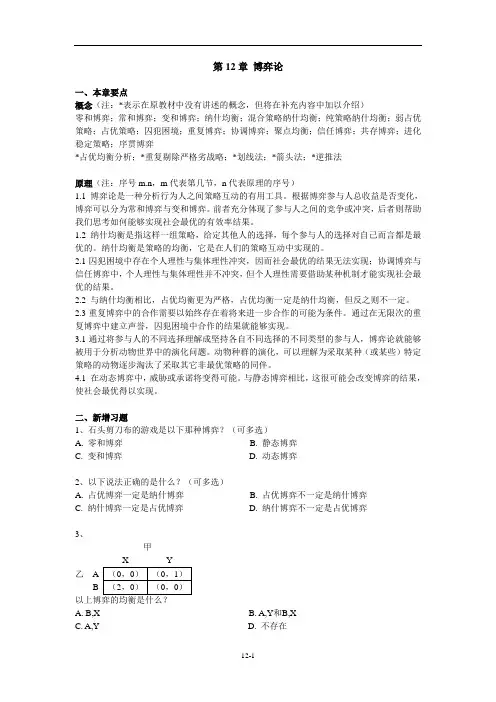
第12章博弈论一、本章要点概念(注:*表示在原教材中没有讲述的概念,但将在补充内容中加以介绍)零和博弈;常和博弈;变和博弈;纳什均衡;混合策略纳什均衡;纯策略纳什均衡;弱占优策略;占优策略;囚犯困境;重复博弈;协调博弈;聚点均衡;信任博弈;共存博弈;进化稳定策略;序贯博弈*占优均衡分析;*重复剔除严格劣战略;*划线法;*箭头法;*逆推法原理(注:序号m.n,m代表第几节,n代表原理的序号)1.1 博弈论是一种分析行为人之间策略互动的有用工具。
根据博弈参与人总收益是否变化,博弈可以分为常和博弈与变和博弈。
前者充分体现了参与人之间的竞争或冲突,后者则帮助我们思考如何能够实现社会最优的有效率结果。
1.2 纳什均衡是指这样一组策略,给定其他人的选择,每个参与人的选择对自己而言都是最优的。
纳什均衡是策略的均衡,它是在人们的策略互动中实现的。
2.1囚犯困境中存在个人理性与集体理性冲突,因而社会最优的结果无法实现;协调博弈与信任博弈中,个人理性与集体理性并不冲突,但个人理性需要借助某种机制才能实现社会最优的结果。
2.2 与纳什均衡相比,占优均衡更为严格,占优均衡一定是纳什均衡,但反之则不一定。
2.3重复博弈中的合作需要以始终存在着将来进一步合作的可能为条件。
通过在无限次的重复博弈中建立声誉,囚犯困境中合作的结果就能够实现。
3.1通过将参与人的不同选择理解成坚持各自不同选择的不同类型的参与人,博弈论就能够被用于分析动物世界中的演化问题。
动物种群的演化,可以理解为采取某种(或某些)特定策略的动物逐步淘汰了采取其它非最优策略的同伴。
4.1 在动态博弈中,威胁或承诺将变得可能。
与静态博弈相比,这很可能会改变博弈的结果,使社会最优得以实现。
二、新增习题1、石头剪刀布的游戏是以下那种博弈?(可多选)A. 零和博弈B. 静态博弈C. 变和博弈D. 动态博弈2、以下说法正确的是什么?(可多选)A. 占优博弈一定是纳什博弈B. 占优博弈不一定是纳什博弈C. 纳什博弈一定是占优博弈D. 纳什博弈不一定是占优博弈3、甲乙 AB以上博弈的均衡是什么?A. B,XB. A,Y和B,XC. A,YD. 不存在4、两家公司甲和乙都希望发展一项新技术,考虑市场风险,技术的兼容性很重要。
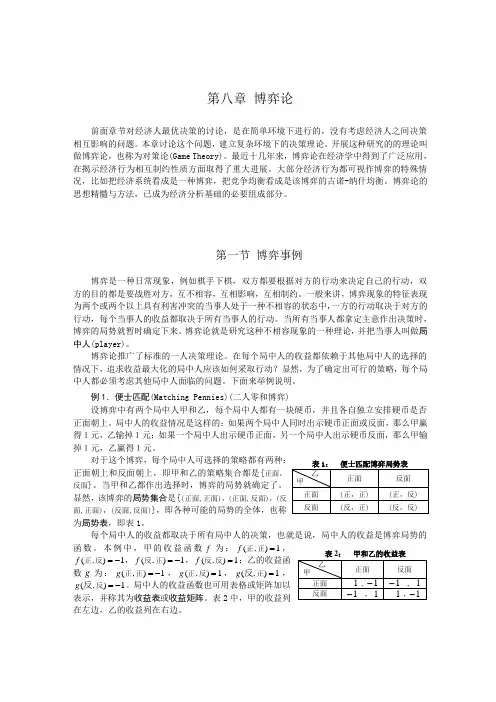
第八章 博弈论前面章节对经济人最优决策的讨论,是在简单环境下进行的,没有考虑经济人之间决策相互影响的问题。
本章讨论这个问题,建立复杂环境下的决策理论。
开展这种研究的的理论叫做博弈论,也称为对策论(Game Theory)。
最近十几年来,博弈论在经济学中得到了广泛应用,在揭示经济行为相互制约性质方面取得了重大进展。
大部分经济行为都可视作博弈的特殊情况,比如把经济系统看成是一种博弈,把竞争均衡看成是该博弈的古诺-纳什均衡。
博弈论的思想精髓与方法,已成为经济分析基础的必要组成部分。
第一节 博弈事例博弈是一种日常现象,例如棋手下棋,双方都要根据对方的行动来决定自己的行动,双方的目的都是要战胜对方,互不相容,互相影响,互相制约。
一般来讲,博弈现象的特征表现为两个或两个以上具有利害冲突的当事人处于一种不相容的状态中,一方的行动取决于对方的行动,每个当事人的收益都取决于所有当事人的行动。
当所有当事人都拿定主意作出决策时,博弈的局势就暂时确定下来。
博弈论就是研究这种不相容现象的一种理论,并把当事人叫做局中人(player)。
博弈论推广了标准的一人决策理论。
在每个局中人的收益都依赖于其他局中人的选择的情况下,追求收益最大化的局中人应该如何采取行动?显然,为了确定出可行的策略,每个局中人都必须考虑其他局中人面临的问题。
下面来举例说明。
例1.便士匹配(Matching Pennies)(二人零和博弈)设博弈中有两个局中人甲和乙,每个局中人都有一块硬币,并且各自独立安排硬币是否正面朝上。
局中人的收益情况是这样的:如果两个局中人同时出示硬币正面或反面,那么甲赢得1元,乙输掉1元;如果一个局中人出示硬币正面,另一个局中人出示硬币反面,那么甲输掉1元,乙赢得1元。
对于这个博弈,每个局中人可选择的策略都有两种:正面朝上和反面朝上,即甲和乙的策略集合都是{正面,反面}。
当甲和乙都作出选择时,博弈的局势就确定了。
显然,该博弈的局势集合是{(正面,正面),(正面,反面),(反面,正面),(反面,反面)},即各种可能的局势的全体,也称为局势表,即表1。
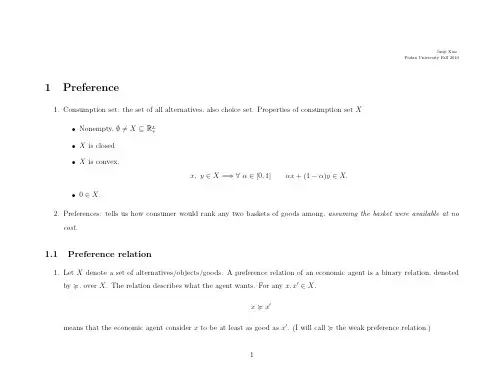
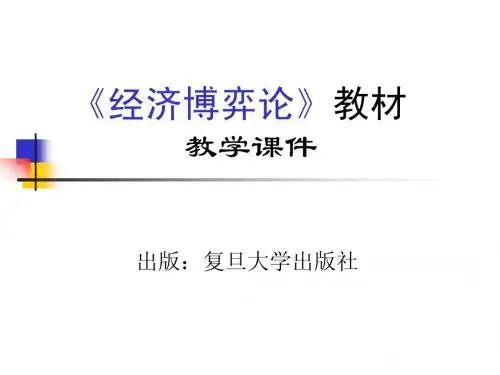
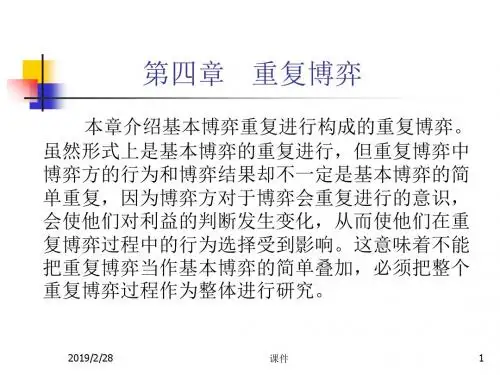
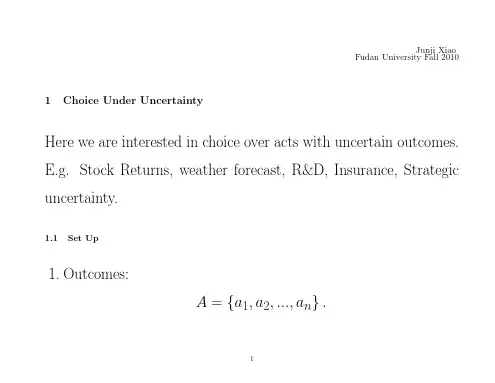
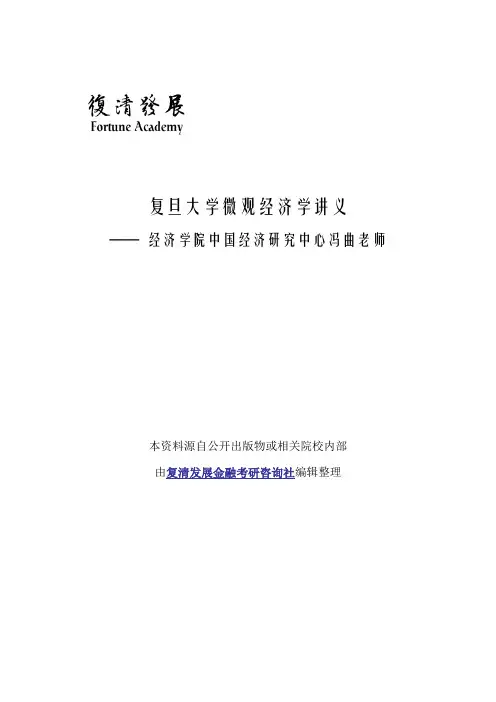
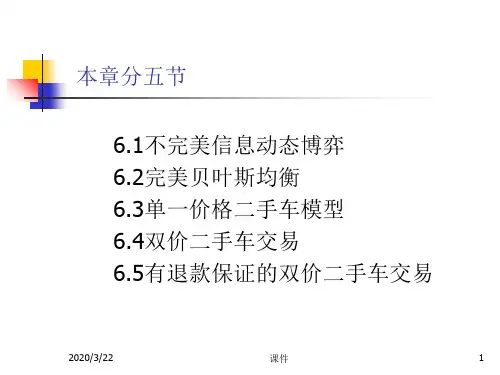
□微◇观经济学讲稿周惠中版第一章导论:经济学和经济思维“经济”的含义:1、指节省、效率,即以较少的耗费获得较大的效果;2、统称人类社会的生产、消费、交换等活动,以及组织这些活动的制度、系统等。
英文“经济”一词economy最早源于古希腊,原意指家计管理。
后来又出现了“政治经济学”和“经济学”的说法。
“政治经济学”(Political Economy)最早出现于17世纪的法国,指对国家事物的公共管理、政策和经济活动。
19世纪,该说法出现了分歧,有的认为它范围太窄,有的认为它太宽。
19世纪末,“经济学”基本上取代了“政治经济学”。
但是20世纪60年代,美国又重提“政治经济学”一词。
现代经济学家认为,经济学是探讨人类社会如何有效率地利用各种资源来满足自己的需求的科学。
具体而言,经济学研究人类在生产、消费、交换和分配中的行为和相互关系。
一、经济理性和资源的相对稀缺性经济学有两个基本假设:人的经济理性和资源的相对稀缺性。
1.及时性、和无代价的假定。
资源被用于一种用途时,二、方法论1.经济模型经济学研究的方法主要是采用经济模型的研究方法。
经济模型就是对经济现实关系的某种主观抽象和概括,用来解释和预测现象的。
经济模型一般都要经过检验才能加以肯定或者否定。
经济模型有两种检验方法:一是直接检验,即检验理论模型的基本假设和描述是否有合理的现实依据。
二是间接检验:即检验经济模型所揭示的规律或论断与实际经验是否相符合。
要注意的是,任何经济理论和模型都只是大致上从某种角度对经济现实进行简化和描述。
因此,某一理论或模型很可能会简化掉持不同观点的理论所特别强调的因素。
这样一来,经济理论和模型的检验常常是很困难的事。
2.实证经济学和规范经济学实证经济学:研究有限的资源在某一经济中是如何被配置和使用的,它试图如实地描述经济活动并揭示其客观规律。
它一般回答“是什么”的问题,而不涉及经济学家的个人价值观念。
规范经济学:回答“应该如何”的问题,往往涉及经济学家个人的价值观念。